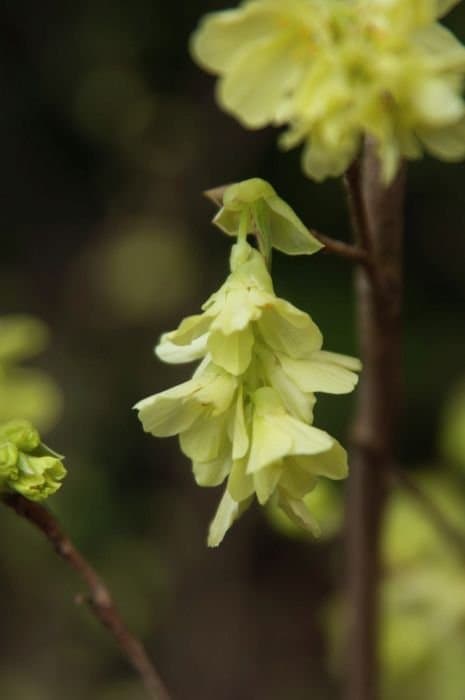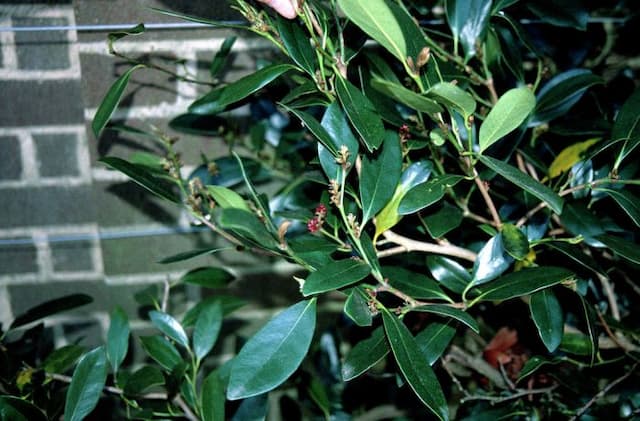Witch Hazel Hamamelis × intermedia 'Chris'

ABOUT
The plant known as Witch Hazel 'Chris' is noted for its distinctive appearance throughout various seasons. This hybrid plant blooms in the late winter to early spring, producing flowers that stand out against the bare branches. The flowers are ribbon-like with a crinkly texture, unfurling in narrow, elongated petals. They come in a warm shade of yellow, giving the plant a striking presence during the coldest months. As spring progresses and turns into summer, the Witch Hazel 'Chris' displays broad leaves that emerge initially with a reddish hue before transitioning to a green color. These leaves are ovate to broadly oval with wavy or slightly toothed margins, contributing to the plant's lush summer appearance. In the fall, the Witch Hazel 'Chris' undergoes another transformation as the leaves adopt vibrant colors before they drop. This seasonal foliage change adds another layer of visual interest, making the plant attractive throughout the year. The leaves might turn into a palette of yellow, orange, and red shades, bearing witness to the changing seasons. The bark, also noteworthy, has a smooth to lightly textured surface, giving the plant a subtle structural appeal even in the absence of leaves during winter. The presence of multiple stems growing from the base of the plant creates a somewhat vase-shaped silhouette, providing a natural and slightly wild aesthetic to gardens and landscapes. Overall, the Witch Hazel 'Chris' is regarded for its multi-seasonal ornamental appeal, offering color and vibrancy when many other plants are dormant, and presenting a constantly-evolving display that captivates gardeners and onlookers alike.
About this plant
 Names
NamesFamily
Hamamelidaceae
Synonyms
Witch Hazel, Hybrid Witch Hazel
Common names
Hamamelis × intermedia 'Chris'.
 Toxicity
ToxicityTo humans
Witch hazel, which is the most common name for Hamamelis × intermedia 'Chris', is generally considered non-toxic to humans. There is no significant evidence to suggest that this plant poses a threat if ingested in small quantities. However, as with any plant, individual allergies or sensitivities could potentially cause reactions in some people. If large quantities of the plant were ingested, it could possibly lead to stomach upset or discomfort due to the astringent properties of witch hazel. In the event of suspected poisoning, seek medical advice.
To pets
Witch hazel is also the most common common name for Hamamelis × intermedia 'Chris' when referring to its toxicity to pets. This plant is not typically toxic to dogs, cats, or other household pets. While not considered poisonous, ingestion of witch hazel in large amounts could potentially cause mild gastrointestinal upset in some pets due to its astringent nature. If you suspect your pet has ingested a large amount of the plant and is showing symptoms like vomiting or diarrhea, it's always a good idea to consult with a veterinarian.
 Characteristics
CharacteristicsLife cycle
Perennials
Foliage type
Deciduous
Color of leaves
Green
Flower color
Yellow
Height
12 feet (3.66 meters)
Spread
12 feet (3.66 meters)
Plant type
Shrub
Hardiness zones
5
Native area
Asia
Benefits
 General Benefits
General Benefits- Aesthetic Appeal: Hamamelis × intermedia 'Chris', commonly known as witch hazel, offers striking yellow to red fall foliage that adds dramatic color to the landscape.
- Winter Interest: Witch hazel is among the few plants that bloom in winter, producing fragrant yellow flowers that provide beauty during the otherwise barren months.
- Wildlife Habitat: The flowers provide nectar for late-season and early-season pollinators, contributing to the ecological health of the area.
- Erosion Control: Witch hazel has a fibrous root system that can help stabilize soil and prevent erosion on slopes or in areas prone to loss of topsoil.
- Low Maintenance: Once established, it requires minimal upkeep beyond occasional pruning to maintain shape and remove any dead wood.
- Versatility: It can be used in a variety of landscape designs, serving as a focal point specimen plant, part of a mixed border, or in naturalistic plantings.
- Tolerance of Different Conditions: Witch hazel is adaptable to a range of soil types, though it prefers well-drained, loamy soil and can tolerate partial shade to full sun.
 Medical Properties
Medical PropertiesThis plant is not used for medical purposes.
 Air-purifying Qualities
Air-purifying QualitiesThis plant is not specifically known for air purifying qualities.
 Other Uses
Other Uses- As a natural dye: Witch Hazel can be used to create dyes for textiles, giving fabrics a subtle, yellowish hue.
- Photographic development: Some photographers have experimented with Witch Hazel extracts as an alternative, natural component in developing photographs.
- Winter interest in gardens: Witch Hazel is prized for its vibrant yellow flowers that bloom in late winter when most other plants are dormant.
- Wildlife habitat: Witch Hazel provides shelter and food for birds and small mammals in the landscape.
- Natural sunscreen: Extracts from Witch Hazel leaves may be included in formulations of natural sunscreens due to their tannins.
- Art and craft supplies: Seed pods and branches can be used in floral arrangements and crafts for their unique shapes and textures.
- Witch Hazel water spritzers: Used as a refreshing facial mist or room spray for a pleasant fragrance.
- Yard and garden tool cleaner: Witch Hazel can be used to clean and disinfect garden tools without harsh chemicals.
- Fire-starting aids: Dry Witch Hazel branches can be used as kindling to start fires due to their good burning properties.
- Natural insect repellent: Some gardeners may use Witch Hazel plant parts to repel certain insects, though this is more anecdotal than scientifically proven.
Interesting Facts
 Feng Shui
Feng ShuiThe Witch Hazel is not used in Feng Shui practice.
 Zodiac Sign Compitability
Zodiac Sign CompitabilityThe Witch Hazel is not used in astrology practice.
 Plant Symbolism
Plant Symbolism- Healing: As a variety of witch hazel, Hamamelis × intermedia 'Chris' shares the symbolic meaning of healing due to the plant's medicinal properties historically used for therapeutic purposes.
- Protection: Witch hazel is often associated with protection, as it was believed to ward off negative energies and even used as divining rods to locate water sources, which were considered as vital and positive energy.
- Uniqueness: The 'Chris' cultivar, like many hybrids, represents uniqueness and stands for the beauty in diversity due to its distinctive traits among other witch hazel varieties.
- Resilience: Blooming in late winter, often while snow is still on the ground, it symbolizes resilience and the ability to endure challenging conditions.
- New Beginnings: As one of the first plants to flower in the year, it can symbolize new beginnings and hope for the year ahead.
 Water
WaterWitch Hazel 'Chris' should be watered deeply and thoroughly to ensure that the water reaches the root zone, usually this means applying about 1 to 1.5 gallons of water for a medium-sized shrub. It’s best to water the plant early in the morning to reduce evaporation and allow the foliage to dry out over the course of the day. During the active growing season in the spring and summer, watering once a week is typically sufficient, but the frequency should be adjusted based on rainfall, with less watering needed during wet periods. In the fall and winter, reduce watering to every two to three weeks, depending on the weather. Always check the soil moisture prior to watering as over-watering can lead to root rot.
 Light
LightWitch Hazel 'Chris' prefers full sun to partial shade. An ideal spot is where the plant can receive at least 4 to 6 hours of direct sunlight daily, which encourages optimal blooming and healthy growth. If planted in too much shade, the plant may not produce as many flowers and could become leggy as it reaches for light. Dappled sunlight is also acceptable, which can be achieved if the plant is placed under the canopy of taller trees that allow some light to filter through.
 Temperature
TemperatureWitch Hazel 'Chris' is tolerant of a wide range of temperatures and is hardy in USDA zones 5 through 8. The plant can survive minimum temperatures of around -20 to -10 degrees Fahrenheit. While it can handle cold winters, the ideal growing temperatures for Witch Hazel 'Chris' are between 60 and 75 degrees Fahrenheit, which are typical in temperate climates. Avoid placing the plant in areas where temperature extremes, either hot or cold, are common.
 Pruning
PruningWitch Hazel 'Chris' should be pruned to maintain its shape and remove any dead or crossed branches, which helps to encourage healthy growth and improve air circulation through the plant. Prune immediately after blooming in late winter or early spring since the plant flowers on the previous year's growth. Periodic thinning of the interior branches can also enhance the display of the fragrant flowers. Major pruning should be done sparingly, as Witch Hazel can be slow to recover from heavy cuts.
 Cleaning
CleaningAs needed
 Soil
SoilWitch Hazel 'Chris' performs best in a well-draining, loamy soil with ample organic matter. A peat-based potting mix amended with perlite and compost is ideal. The desired soil pH should be slightly acidic to neutral, ranging from 5.5 to 7.0.
 Repotting
RepottingWitch Hazel 'Chris' should be repotted every 3-4 years or when it becomes root-bound. Early spring, just before the growing season, is the best time for repotting this shrub.
 Humidity & Misting
Humidity & MistingWitch Hazel 'Chris' thrives in moderate humidity levels, similar to those found in its natural woodland environment. It can tolerate some variation, but consistently high humidity is not necessary for its growth.
 Suitable locations
Suitable locationsIndoor
Provide bright filtered light and moderate humidity.
Outdoor
Full sun to partial shade, sheltered from strong winds.
Hardiness zone
5-8 USDA
 Life cycle
Life cycleHamamelis × intermedia 'Chris', commonly known as Witch Hazel 'Chris', starts its life cycle when the seeds are dispersed, often by exploding fruit capsules ejecting seeds at maturity. Upon finding suitable soil, the seeds germinate, establishing a root system and producing shoots that develop into young saplings. As the plant matures, it develops a woody stem and branches, with foliage comprising broad leaves that exhibit a characteristic green color that turns to vibrant yellow to red in the fall. Witch Hazel 'Chris' typically flowers from late winter to early spring, producing fragrant yellow to red flowers with strap-like petals before the emergence of new leaves. The plant reaches reproductive maturity and starts producing its own seeds to complete the cycle within a few years. It can also be propagated vegetatively through cuttings, allowing gardeners to bypass the seed stage for faster maturation.
 Propogation
PropogationPropogation time
Late winter
Hamamelis × intermedia 'Chris', commonly known as the hybrid witch hazel 'Chris', is often propagated via softwood cuttings. This method is popular as it tends to be more reliable for preserving the characteristics of this particular cultivar. The best time for taking softwood cuttings is late spring to early summer, when new growth is still tender but mature enough to handle propagation procedures. A rooting hormone is commonly applied to the cut end of the cutting to encourage root development. After the hormone treatment, the cutting is placed in a well-draining rooting medium, such as a mix of perlite and peat, and kept under high humidity and indirect light until roots have established, which usually takes several weeks. Once rooted, the young plants can be transferred to individual pots and gradually accustomed to less humid conditions before planting out in the garden.









